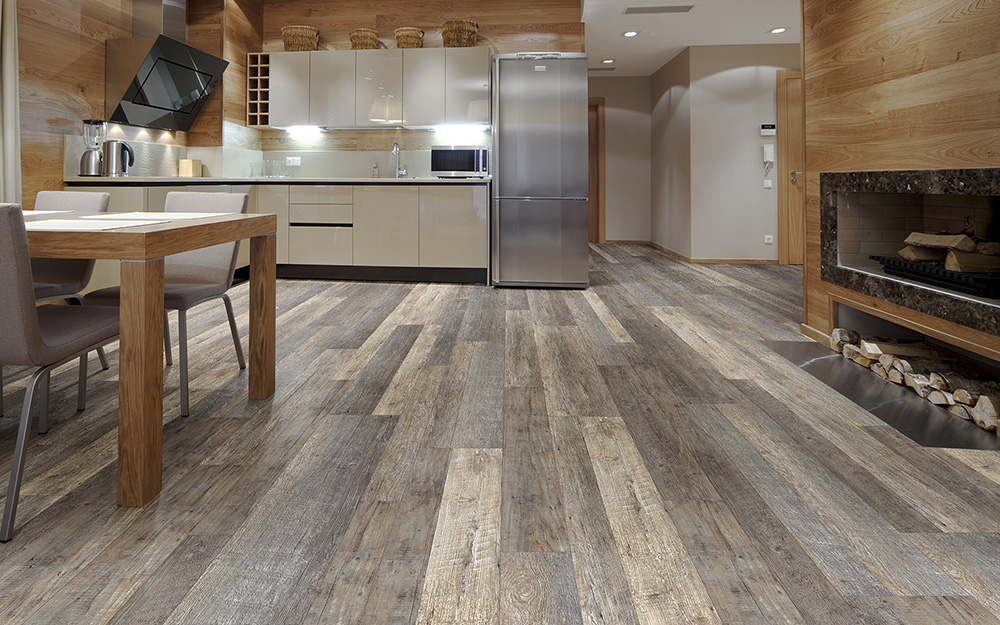Types of Vinyl Flooring

Last updated April 2, 2024
Today’s vinyl flooring looks almost identical to the more expensive options like hardwood, ceramic, marble or stone. Affordable, durable, scratch- and water-resistant, vinyl floors are a great option for just about every interior living space. This guide highlights popular types of vinyl flooring, explains why the wear layer you choose is important and describes the different finishes. Plus, you'll get tips on how to maintain vinyl flooring.
Tip: Lighter colored flooring makes smaller rooms feel more spacious,
while darker flooring makes larger rooms feel cozier.
Table of Contents
Vinyl Flooring Types
Vinyl Plank Flooring
Vinyl Sheet Flooring
Peel and Stick Vinyl Flooring
Vinyl Flooring Wear Layer Choices
Vinyl Floor Maintenance
Vinyl Flooring Types

Popular types of vinyl flooring include plank, sheet and peel and stick. With everything from realistic wood-look embossed planks to ceramic-look tiles, you can buy vinyl flooring in a wide range of colors and designs. It is resistant to moisture and endures daily wear and tear. It works well in rooms with a lot of foot traffic.
- Vinyl plank flooring has the richness, deep texture and look of real hardwood flooring without the high cost.
- Vinyl sheet flooring works well in large spaces and is easy to maintain.
- Peel and stick vinyl flooring
tiles are removable and
quick and easy to install, making them one
the best vinyl flooring choices for small spaces.
They have adhesive backing so you can place them easily with no extra materials or tools.
Tip: Choose sheet vinyl for installing in large spaces and use tiles for bathroom vinyl flooring
or other smaller rooms.
Vinyl Plank Flooring

Most types of
vinyl plank flooring have a foam core that delivers rigidity and strength. Vinyl planks are easy to install. Click-lock vinyl plank flooring can be installed over existing surfaces including concrete, tile, wood and vinyl with a simple tongue-and-groove click-together technique.
- Add the warm, comfortable style of real wood to interior living spaces.
- Some luxury vinyl flooring types are 100 percent waterproof.
- An attached underlayment minimizes sound, absorbs shocks and enhances comfort.
- Great for use in basements, kitchens, bathrooms and high-traffic areas.
Tip: Waterproof vinyl flooring and non-slip vinyl flooring are great options for mudrooms and bathrooms.
Vinyl Sheet Flooring

Sheet vinyl comes in rolls typically measuring 6 or 12 feet wide and is available in a variety of colors and designs. It has a fiberglass core that will not crack, curl, expand or contract, allowing it to be installed anywhere in the home, including high-moisture areas.
Vinyl sheet flooring has three different backings with different installation requirements.
- Adhesive vinyl flooring typically has a felt-backed vinyl sheet,
and
the entire floor must be covered with adhesive or glue. - A modified loose-lay vinyl sheet has a fiberglass backing and doesn’t require adhesive.
- A vinyl-backed sheet is usually only glued at the edges and should be professionally installed.
Peel and Stick Vinyl Flooring

Installing peel and stick vinyl flooring is an ideal DIY project, particularly in smaller rooms. Peel and stick vinyl flooring can be purchased in tiles or planks and has an adhesive backing. Install by lining up tiles at room edges. Make precise cuts to ensure a
proper fit.
- Groutable vinyl flooring tile is a cost-effective and moisture-resistant product that’s great for bathrooms and kitchens.
- Peel and stick vinyl flooring is appropriate for both residential and commercial uses. It has a low-gloss texture finish that is easy to clean and maintain.
- Purchase all vinyl tiles or planks for the same project from the same lot. Even if they are labeled the same pattern and color, slight differences in shade may occur between lots.
Vinyl Flooring Wear Layer Choices

The wear layer of vinyl flooring is the urethane-based topcoat and finish that prevents scuffs, dents, scrapes and stains. The thicker the wear layer, the more durable and long-lasting your vinyl flooring will be. Thickness is measured in units called
mils, with 1-mil being about as thick as a human hair.
No-Wax Vinyl:
- Stain-resistant
- Remains shiny without polishing or buffing
- Economical
Urethane:
- Stain-resistant
- Remains shiny without polishing or buffing
- Easy to clean
- Durable
- More resistant to scuffing
Enhanced Urethane:
- Resists scuffs and scratches
- Stain-resistant
- Easy to clean
- Greatest durability
- Retains shine longest without buffing or polish
Vinyl Floor Maintenance

Vinyl flooring is easy to maintain and requires no polish or wax. Most have a clear wear layer that protects against standard household stains, but some vinyl floor brands also guard against permanent markers, ketchup, mustard and other tough stains.
- Regularly sweep, dust, damp mop or vacuum your floor to prevent scratches.
Vinyl flooring is much more scratch-resistant that other types of flooring, such as hardwood, but keeping it clean will ensure it stays scratch-free
for many years to come. - Use a pH-neutral floor cleaner and avoid cleaning agents containing wax, oil or polish. Read the product's use and care guide for product-specific information.
- Promptly remove any standing water, pet urine or other liquids, even on water-resistant vinyl flooring.
- Do not use a steam cleaner or vacuum with a beater bar.
- Use flat floor protectors (nylon or felt) on all furniture legs.
- Keep your
pet's nails trimmed.
When you need a durable and affordable flooring option, all types of vinyl flooring can make great additions to your home. Vinyl flooring is a popular choice for DIYers, but if you’d rather leave the job to a professional, trust our vinyl flooring installation services. We offer in-home measurements and quotes specific to your choice of vinyl floors.






























